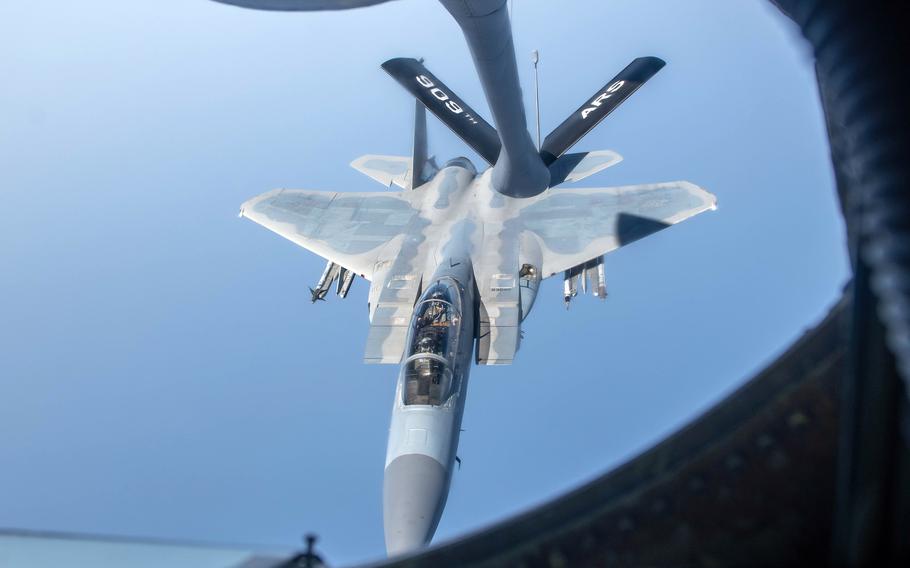
Pacific Air Forces commander Gen. Ken Wilsbach pilots an F-15D Eagle assigned to Kadena Air Base, Okinawa, somewhere over the Pacific Ocean, April 17, 2023. (Alexis Redin/U.S. Air Force)
TOKYO — Replacing squadrons of F-15 Eagles on Okinawa with rotating contingents of more advanced fighters will allow U.S. forces to disperse and survive if a war with China breaks out over Taiwan, a Japanese security expert said Thursday.
Fighter swaps was one topic that Takuya Matsuda, a research fellow with the Yokosuka Council on Asia-Pacific Studies, touched on during a public forum at Fussa Citizen’s Hall, just outside the gates of Yokota Air Base in western Tokyo.
Two F-15C/D squadrons at Kadena Air Base, Okinawa — nearly 50 fighters — are being phased out over two years and replaced by rotating squadrons of aircraft from as far away as Germany and Alaska. The inventory of replacements thus far includes F-22 Raptor stealth fighters and F-16 Fighting Falcons.
China’s force of hundreds of missile launchers with the ability to strike Okinawa factors into the decision to retire Kadena’s two permanent F-15 squadrons, Matsuda said.
“Kadena demonstrates U.S. commitment to defense of the first island chain,” he said.
The first island chain includes Taiwan, Okinawa and the Philippines and separates the East and South China Seas from the Pacific Ocean. Military strategists believe that China’s goal is to push American and allied forces out of both seas.
Many people instinctively criticized the plan to withdraw the F-15s from Okinawa, Matsuda said.
For example, retired Air Force Lt. Gen. Dan Leaf, a former deputy commander of the U.S. Pacific Command, said withdrawing the Eagles sent China the wrong message.
“It is a lack of commitment in their minds,” he said Nov. 16, after the Air Force announced the plan. “In terms of deterrence it’s a net negative. That element can’t be undone by saying we are going to rotate, or the planes are more capable.”
However, Matsuda noted Kadena’s proximity to a potential combat zone near Taiwan, which Beijing considers a breakaway province that must be reunified with the mainland, by force if necessary.
“Resilience comes into play,” he said.
Scattering forces away from Kadena in a conflict heightens their ability to recover from an attack, fight on and deprive China of a quick and decisive victory, Matsuda said.
In Ukraine, Russia sought such a decisive victory but was unable to capture the country’s capital, Kiev, last year, he said.
The U.S. and Japan could turn a Taiwan conflict into a war of attrition and increase the costs for China, Matsuda said.